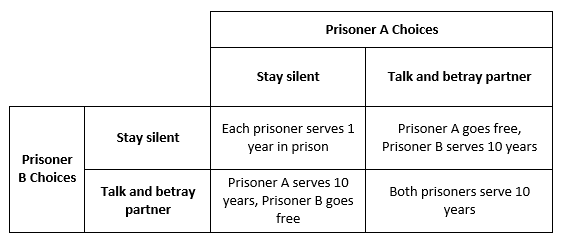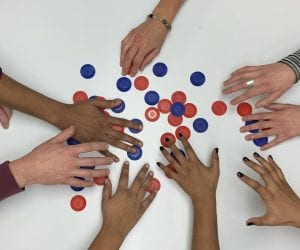Game theory is the study of human cooperation and conflict in competitive situations. A lot of people may be intimidated by the topic of game theory, because it sounds complex. But game theory can be understood in very simple terms, and it can be a powerful teaching tool for students working to understand world history, modern political interactions, and environmental science. Simply put, game theory assumes that the players act rationally—that they will try to make the best decision to obtain their own best possible outcome—and then examines how different situations play out.
An Introduction To Game Theory: The Prisoner’s Dilemma
A great introductory example of game theory is called the prisoner’s dilemma. Imagine that two people robbed a bank together, and they got caught, but the police don’t have enough evidence to convict them both on all charges. The prisoners are placed in different rooms, and each is told that if he turns on his co-conspirator and talks, then he will walk free while the other takes the full prison sentence.

We can use the game board matrix on the left to represent this situation, showing the options for each prisoner and the 4 distinct possible outcomes.
If each prisoner ranks these outcomes, they would certainly prefer to go free over spending 1 year in prison and would place the “10 years in prison” option at the bottom of their list. However, if both players act to achieve their best outcome—betraying their partner in order to go free—then they will both end up with their worst outcome. Both would go to prison for the maximum possible sentence. This pattern would repeat every time the game is played, because betraying your partner is the best choice for a prisoner hoping to go free.
When a particular game theory situation has a predictable outcome like this, it’s called equilibrium. This equilibrium can be difficult to break, because all players must be invested in choosing a different strategy—one that doesn’t result in their number one outcome—and must trust other players to use that strategy as well.
Game Theory In Ecology With Shared Natural Resources
A version of this dilemma plays out in ecology with shared natural resources. This phenomenon, called The Tragedy of the Commons, occurs when individuals, acting in their own rational self-interest, deplete a shared resource such that it can no longer be used in the future. This results in short-term gain, but in the long-term, a “tragedy” or worst possible outcome for all. For example, an individual commercial fisher may take as many fish as they can catch in order to maximize profit. But if every boat on the ocean pursues this strategy, then there will be no remaining fish and no opportunity for the fishery to replenish itself. Ultimately, all fishers will experience long-term losses and potentially go out of business, while damaging the ecosystem. In order to break out of this equilibrium, all of the fishing boats must agree to sustainable harvests, and all of them must follow this rule once it’s set. This paradigm applies not only to our ocean fisheries but to all kinds of renewable, shared resources—from rainforests to clean water to unpolluted air.
Teaching Middle School Students About The Tragedy of the Commons
Population Education’s lesson plan For the Common Good uses a simple and fun demonstration to teach students about the Tragedy of the Commons. Students compete to earn candy without communicating with their peers, and will almost always experience the “tragedy” of running out of their shared resource after just a single round. Then they have the opportunity to play again—this time after talking out a strategy and working together to make a plan for the future. Through dialogue and holding each other accountable, students learn how to share their resources fairly, so that everyone can earn the coveted candy reward.
As our rapidly growing global family must share limited natural resources, it is more important than ever to prepare students who understand the power of open communication and long-term thinking, so that we can break out of equilibrium and co-exist sustainably. You can download this lesson plan and other excellent resources from our new middle school curriculum kit, People and the Planet.




